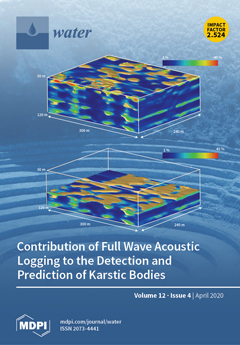The high-energy consumption of wastewater treatment plants (WWTPs) is a crucial issue for municipalities worldwide. Most WWTPs in Greece operate as extended aeration plants, which results in high operational costs due to high energy needs. The present study investigated the energy requirements of 17 activated sludge WWTPs in Greece, serving between 1100–56,000 inhabitants (population equivalent, PE), with average daily incoming flowrates between 300–27,300 m
3/d. The daily wastewater production per inhabitant was found to lie between 0.052 m
3/PE·d and 0.426 m
3/PE·d, with average volume of 0.217 ± 0.114 m
3/PE·d. The electric energy consumption per volume unit (E
Q (kWh/m
3)) was between 0.128–2.280 kWh/m
3 (average 0.903 ± 0.509 kWh/m
3) following a near logarithmic descending correlation with the average incoming flowrate (Q
av) (E
Q = −0.294
lnQ
av + 3.1891; R
2 = 0.5337). A similar relationship was found between the daily electric energy requirements for wastewater treatment per inhabitant (E
PE (kWh/PE·d)) as a function of PE, which varied from 0.041–0.407 kWh/PE·d (average 0.167 ± 0.101 kWh/PE·d)) (E
PE = −0.073
ln(PE) + 0.8425; R
2 = 0.6989). Similarly, the daily energy cost per inhabitant (E
€/PE (€/PE·d)) as a function of PE and the electric energy cost per wastewater volume unit (E
€/V (€/m
3)) as a function of average daily flow (Q
av) were found to follow near logarithmic trends (E
€/PE = −0.013
ln(PE) + 0.1473; R
2 = 0.6388, and E
€/V = −0.052
lnQ
av + 0.5151; R
2 = 0.6359), respectively), with E
€/PE varying between 0.005–0.073 €/PE·d (average 0.024 ± 0.019 €/PE·d) and E
€/V between 0.012–0.291 €/m
3 (average 0.111 ± 0.077 €/m
3). Finally, it was calculated that, in an average WWTP, the aeration process is the main energy sink, consuming about 67.2% of the total electric energy supply to the plant. The large variation of energy requirements per inlet volume unit and per inhabitant served, indicate that there is large ground for improving the performance of the WWTPs, with respect to energy consumption.
Full article





